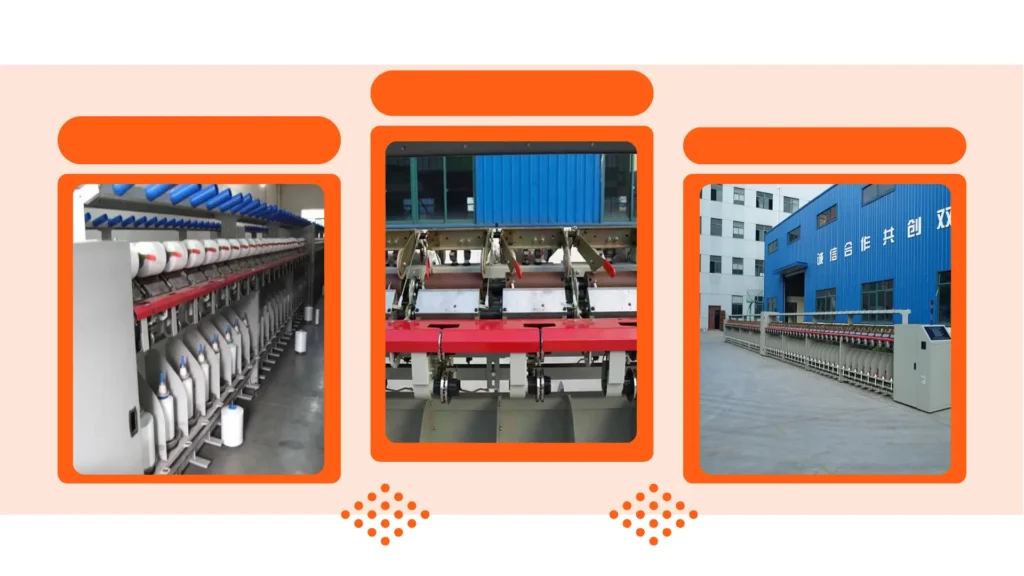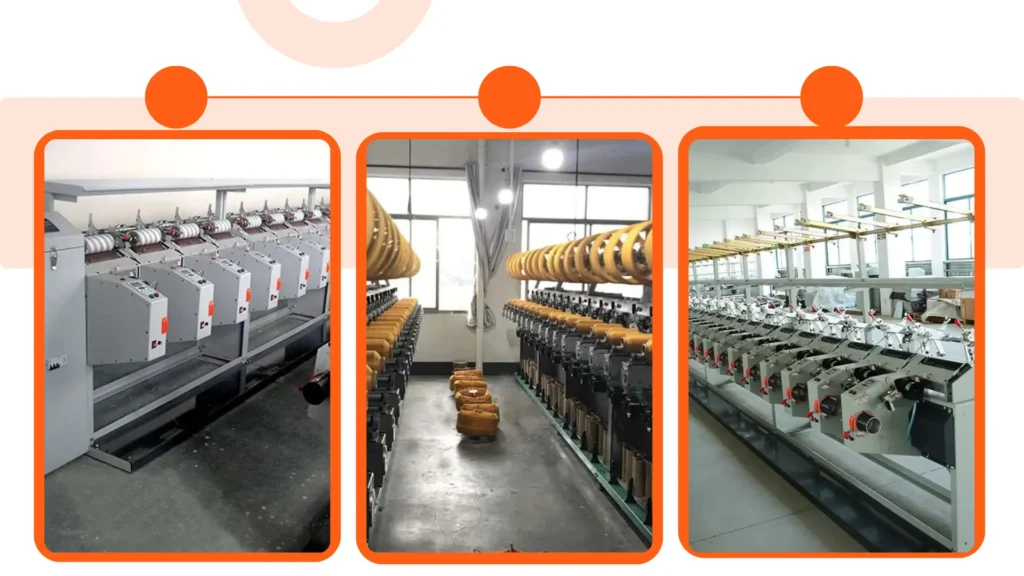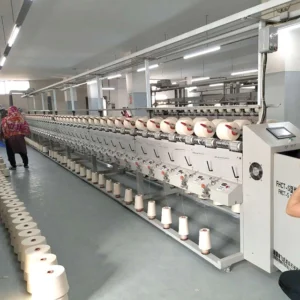Energy consumption is a critical concern for textile manufacturers, as it directly impacts operational costs and environmental sustainability.
With rising energy prices and increasing pressure to reduce carbon footprints, finding effective strategies to track and minimize energy use has become essential.
This article explores practical and actionable strategies that textile manufacturing facilities can implement to monitor energy consumption, identify inefficiencies, and reduce overall energy usage.
By adopting these strategies, manufacturers can lower costs, improve sustainability, and enhance their competitiveness in the market.
And More:
- Ways to Achieve Carbon Neutrality in the Textile Industry
- How Can Textile Factories Reduce Their Carbon Footprint?
- Top 10 Small CNC Winding Machine Manufacturers in China
Why Is Tracking Energy Use Important for Textile Manufacturers?
Understanding Energy Consumption Patterns
Tracking energy use helps manufacturers identify when and where energy is being consumed most.
This data is crucial for pinpointing inefficiencies and optimizing energy usage across different stages of production.
For example, a manufacturer might discover that a significant portion of energy is consumed during the dyeing process, which could prompt them to explore more energy-efficient dyeing technologies.
By understanding these patterns, manufacturers can make informed decisions about where to focus their energy-saving efforts, ensuring that resources are used as efficiently as possible.
Reducing Operational Costs
Energy is one of the largest expenses in textile manufacturing. By monitoring and minimizing energy use, manufacturers can significantly lower operational costs and improve profitability.
For instance, reducing energy consumption by just 10% can lead to substantial savings, especially for large-scale facilities.
These savings can then be reinvested into other areas of the business, such as research and development or employee training.
Additionally, lower energy costs can make manufacturers more competitive in the market, allowing them to offer more attractive pricing to customers.
Meeting Sustainability Goals
Consumers and regulators are increasingly demanding sustainable practices. Tracking energy use allows manufacturers to measure their environmental impact and demonstrate progress toward sustainability goals.
For example, a company that reduces its energy consumption can showcase this achievement in its sustainability reports, enhancing its reputation among eco-conscious consumers and stakeholders.
Meeting these goals not only helps manufacturers comply with regulations but also positions them as leaders in sustainable textile production, which can attract new business opportunities and partnerships.
What Are the Key Sources of Energy Consumption in Textile Manufacturing?
Machinery and Equipment
Textile manufacturing relies heavily on machinery such as looms, knitting machines, and dyeing equipment, which consume significant amounts of energy. Identifying energy-intensive machines is the first step toward optimization.
For example, older looms may use more energy than newer, energy-efficient models.
By upgrading to modern machinery or retrofitting existing equipment with energy-saving technologies, manufacturers can reduce energy consumption without compromising productivity.
Regular maintenance of these machines also ensures they operate efficiently, further minimizing energy use.
Heating, Ventilation, and Air Conditioning (HVAC)
HVAC systems are essential for maintaining optimal working conditions but can be major energy consumers. Proper management of these systems is critical for reducing energy use.
For instance, installing programmable thermostats can help regulate temperature settings based on occupancy and production schedules, reducing unnecessary energy consumption.
Additionally, regular maintenance of HVAC systems, such as cleaning filters and checking for leaks, ensures they operate at peak efficiency.
By optimizing HVAC systems, manufacturers can create a comfortable working environment while minimizing energy waste.
Lighting and Auxiliary Systems
Lighting, conveyor belts, and other auxiliary systems also contribute to energy consumption. While they may seem minor, optimizing these systems can lead to substantial energy savings.
For example, replacing traditional incandescent bulbs with LED lighting can reduce energy use by up to 75%.
Similarly, installing motion sensors or timers for lighting in low-traffic areas ensures that lights are only on when needed.
By addressing these smaller but significant energy consumers, manufacturers can achieve cumulative savings that contribute to overall energy reduction goals.
How Can Manufacturers Track Energy Use Effectively?
Installing Smart Meters and Sensors
Smart meters and sensors provide real-time data on energy consumption, allowing manufacturers to monitor usage patterns and identify inefficiencies. These tools are essential for accurate energy tracking.
For example, smart meters can track energy use at the machine level, providing detailed insights into which equipment consumes the most energy.
This data enables manufacturers to make targeted improvements, such as adjusting machine settings or scheduling maintenance, to reduce energy waste.
By leveraging smart technology, manufacturers can gain a comprehensive understanding of their energy use and take proactive steps to optimize it.
Implementing Energy Management Systems (EMS)
An EMS integrates data from various sources to provide a comprehensive view of energy use. It helps manufacturers analyze trends, set benchmarks, and track progress toward energy reduction goals.
For instance, an EMS can generate reports that highlight energy consumption patterns over time, allowing manufacturers to identify seasonal variations or anomalies.
This information can inform strategic decisions, such as adjusting production schedules or investing in energy-efficient equipment.
By implementing an EMS, manufacturers can streamline their energy management processes and achieve greater efficiency.
Conducting Regular Energy Audits
Energy audits involve a detailed assessment of energy use across the facility. They help identify areas of waste and provide actionable recommendations for improvement.
For example, an energy audit might reveal that a significant amount of energy is lost due to poor insulation or outdated equipment.
Based on these findings, manufacturers can implement targeted solutions, such as upgrading insulation or replacing inefficient machinery.
Regular energy audits ensure that manufacturers stay on top of their energy use and continuously identify opportunities for improvement.
What Strategies Can Minimize Energy Use in Textile Manufacturing?
Upgrading to Energy-Efficient Machinery
Replacing outdated equipment with energy-efficient models can significantly reduce energy consumption.
Modern machines are designed to operate more efficiently, often with lower energy requirements.
For example, energy-efficient dyeing machines use advanced technologies to reduce water and energy use while maintaining high-quality results.
While the initial investment in new machinery may be high, the long-term savings in energy costs and improved productivity make it a worthwhile investment.
Additionally, many governments offer incentives or grants for upgrading to energy-efficient equipment, further offsetting the costs.
Optimizing Production Processes
Streamlining production processes, such as reducing idle times and improving workflow, can minimize energy waste.
For example, scheduling high-energy tasks during off-peak hours can lower energy costs by taking advantage of lower electricity rates.
Additionally, optimizing the layout of production lines can reduce the need for energy-intensive transportation of materials within the facility.
By analyzing and refining production processes, manufacturers can identify inefficiencies and implement changes that reduce energy consumption without compromising output.
Implementing Preventive Maintenance
Regular maintenance of machinery and equipment ensures they operate at peak efficiency. Poorly maintained machines often consume more energy and are more prone to breakdowns.
For example, cleaning and lubricating moving parts can reduce friction, lowering energy consumption and extending the lifespan of the equipment.
Preventive maintenance also helps identify potential issues before they become major problems, reducing downtime and repair costs.
By prioritizing maintenance, manufacturers can ensure that their equipment operates efficiently, minimizing energy waste and maximizing productivity.
How Can Renewable Energy Sources Be Integrated?
Installing Solar Panels
Solar panels can provide a clean and renewable source of energy for textile facilities.
They are particularly effective in regions with high sunlight exposure and can significantly reduce reliance on grid electricity.
For example, a textile manufacturer in a sunny region could install solar panels on the roof of their facility to generate a portion of their energy needs.
This not only reduces energy costs but also lowers the facility’s carbon footprint.
Additionally, excess energy generated by solar panels can be stored or sold back to the grid, providing an additional revenue stream.
Utilizing Wind Energy
Wind turbines can be a viable option for facilities located in windy areas. They offer a sustainable energy source that can complement or replace traditional energy supplies.
For instance, a textile manufacturer in a coastal region could install wind turbines to generate electricity for their operations.
Wind energy is particularly effective for large-scale facilities that require significant amounts of power.
By integrating wind energy, manufacturers can reduce their reliance on fossil fuels and contribute to a more sustainable energy mix.
Exploring Biomass Energy
Biomass energy, derived from organic materials, can be used to generate heat or electricity. It is a renewable option that can help reduce the carbon footprint of textile manufacturing.
For example, a manufacturer could use agricultural waste or wood pellets as a biomass fuel source to power their boilers or generate electricity.
Biomass energy is particularly useful for facilities located in rural areas with access to abundant organic materials.
By exploring biomass energy, manufacturers can diversify their energy sources and reduce their environmental impact.
How Can Manufacturers Start Their Energy Reduction Journey?
Setting Clear Energy Reduction Goals
Establishing specific, measurable goals provides direction and motivation for energy reduction efforts. Goals should align with the facility’s overall sustainability strategy.
For example, a manufacturer might set a goal to reduce energy consumption by 15% within two years. Clear goals help focus efforts and provide a benchmark for measuring progress.
By setting achievable targets, manufacturers can create a roadmap for energy reduction and ensure that their efforts are aligned with broader sustainability objectives.
Partnering with Energy Experts
Collaborating with energy consultants or technology providers can help manufacturers identify the most effective strategies for their specific needs. Expertise is invaluable for successful implementation.
For instance, an energy consultant can conduct a detailed assessment of the facility’s energy use and recommend tailored solutions, such as upgrading equipment or optimizing processes.
By partnering with experts, manufacturers can access the knowledge and resources needed to achieve their energy reduction goals efficiently and effectively.
Monitoring and Continuous Improvement
Regularly tracking energy use and evaluating the effectiveness of implemented strategies ensures continuous improvement.
This iterative approach helps manufacturers stay on track toward their energy reduction goals. For example, monthly energy reports can highlight progress and identify areas
for further improvement.
Additionally, regular reviews of energy management practices can help manufacturers adapt to changing conditions or new technologies.
By committing to continuous improvement, manufacturers can achieve long-term energy efficiency and sustainability.
Conclusion
Tracking and minimizing energy use in textile manufacturing facilities is not only a cost-saving measure but also a critical step toward sustainability.
By understanding energy consumption patterns, adopting energy-efficient technologies, and fostering a culture of sustainability, manufacturers can significantly reduce their energy use and environmental impact.
The long-term benefits, including cost savings, enhanced competitiveness, and a reduced carbon footprint, make energy reduction a worthwhile investment.
As the textile industry continues to evolve, prioritizing energy efficiency will be key to building a sustainable and profitable future.










